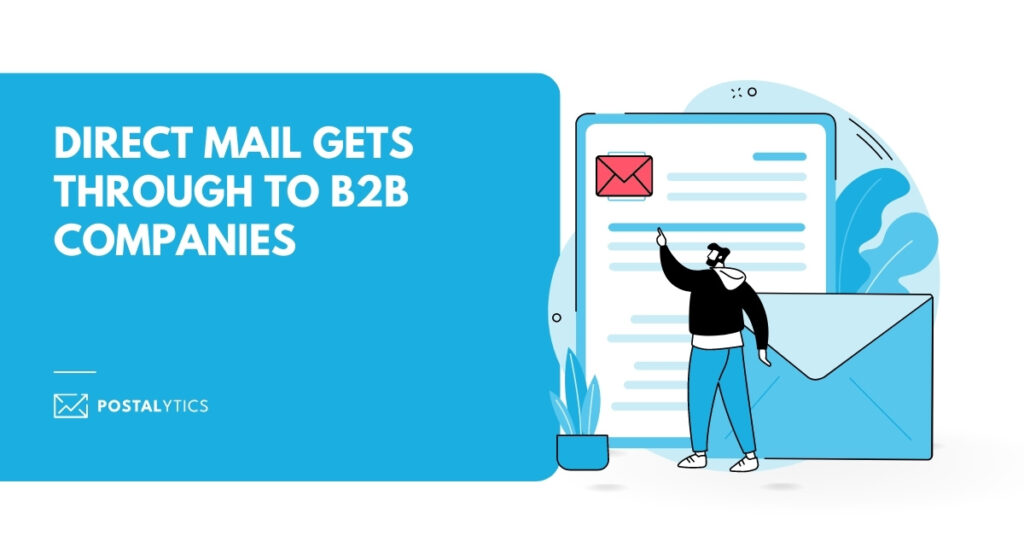
Direct-mail advertising is a tried and proven method of reaching consumers, and it is equally effective for businesses that sell to other companies.
Direct mail is used by large enterprises and medium to small-sized businesses – from retail stores, realtors, banks, and financial institutions to media and entertainment firms, governments, and transportation/logistics companies. Adequately targeted and designed postcards and letters can:
- Help business buyers recognize the brand
- Build thought-leadership reputations
- Direct prospects to online resources where they can learn more about a company’s goods and services
The global direct mail advertising market is expected to reach more than $73 billion over the next three years (compound annual growth rate of 0.3%), according to market research firm ReportLinker. Direct marketers mailed more than 6.3 billion pieces in Q3 ’22, according to other industry tracking data. Through last September, direct mail volume for 2022 totaled 25.9 billion pieces – an increase of 3.4% from 2021 volumes during the same period. One mailing firm has reported sending an average of 3.1 million pieces of mail each week — 15% more than in 2021.
What We’ll Cover:
B2B Direct Mail Advantages
Why is there so much ink (or toner) on paper in the mail stream? Competing with the barrage of daily emails, website solicitations and even LinkedIn advertisements, many brand managers, including business-to-business (B2B) marketers, seek to rise above the online clutter.
“There is definitely more direct mail being produced now than in the recent past,” acknowledges Curt Schultz, creative director at Paul Gregory Media, a digital marketing agency in Naperville, IL. “That’s primarily because digital [as a promotional medium] is over-saturated. For more impact, people are going back to some of that print work.”
The primary types of direct-mail advertising aimed at businesses are postcards, self-mailers (sans envelope), letters in envelopes, dimensional mailers, brochures, and catalogs. Much of this material works hand-in-hand with digital resources. Postcards, two-sided letters, card inserts, or trifolds and buck slips often feature references to landing-page URLs and encourage customers to contact companies via email.
Though email might seem the logical choice for B2B marketers, Schultz points to two common problems:
1) Due to the sheer volume of electronic messages being transmitted, a large percentage of business email gets ignored and goes unread.
2) Many business email systems filter messages or block images, which decreases impressions and lessens the desired impact of the marketing message.
“With printed direct mail, if someone at a business receives it, they’re going to see it,” he observes. And the personalized, variable-data capabilities of digital presses substantially improve response rates – marking another way the print medium stays competitive with its e-counterparts.
The relationship between so-called competing media can be symbiotic as opposed to adversarial. “Cadence is a key strategic component,” stresses Corey Ciszek, another veteran agency creative director based north of Chicago in Evanston, IL. “Omnichannel marketers want to get in front of their business customer audiences in every way – online and in print. To work best, efforts need to be integrated, coordinated, and complementary.” For example, a series of two emails may kick off a marketing campaign, followed up by a postcard reminder. Nearly 85% of marketers agree that direct mail dramatically increases digital campaign performance, including improved conversion rates and overall investment return, according to research conducted by NAPCO Media.
Here’s a great article about the role of direct mail in a digital marketing strategy.
Mail Metrics and Design
Even when accounting for the added costs of printing and postage, direct-mail touchpoints can be highly cost effective. Most B2B marketers demand data analytics so they can measure campaign success. The average response rate for direct mail is between 2.7% and 4.4%, according to U.K. firm Postary. By comparison, email response rates average around 0.6%. The average direct mail open rate varies between 57.5% and 85%, and the average ROI is $4.09 for every $1.27 spent on direct mail.
A different design hierarchy governs the creation of printed pieces. “Variables include the physical dimensions of the piece and whether it will include digital elements, such as a QR code or landing page URL,” Schultz says.
“You don’t want the piece to look like ‘junk mail,’” Ciszek adds. “The challenge is to present content in an interesting manner that is also concise.” One direct-mail best practice is to repeat the offer/benefit information in two different ways. If discounts and features are included in the body of the piece, consider using a sidebar to repeat the information visually using icons.
Another benefit of B2B direct mail is: Print is perceived as being more tangible, more trustworthy, and “not as cold” as electronic communication, Ciszek concludes. “Mail is easy to save and keep track of as a reminder. We all know what a pain searching through our jam-packed email in-boxes can be.”
A platform like Postalytics provides B2B marketers with all the metrics they need to track and evaluate their direct mail campaigns. Using techniques such as intelligent mail barcodes, QR codes, and personalized URLs, Postalytics customers know when their mail is delivered, and they can track the responses and conversions.
Learn more about how to benefit from direct mail analytics in this article: Direct Mail KPIs: How To Analyze Direct Mail Results Using 5 Key Metrics
Direct mail for business works for many of the same reasons it is effective with consumers. It gets attention, communicates value, and works well with digital marketing efforts. If your company sells to businesses, be sure you don’t overlook the potential of B2B direct mail.
About the Author

Dennis Kelly
Dennis Kelly is CEO and co-founder of Postalytics. Dennis joined Boingnet, the predecessor to Postalytics, in 2013. Boingnet was focused on providing print and direct mail marketing service providers the ability to add digital marketing channels to their direct mail campaigns. Postalytics is Dennis’ 6th startup. He has been involved in starting and growing early-stage technology ventures for over 30 years and has held senior management roles at a diverse set of large technology firms including Computer Associates, Palm Inc. and Achieve Healthcare Information Systems.
